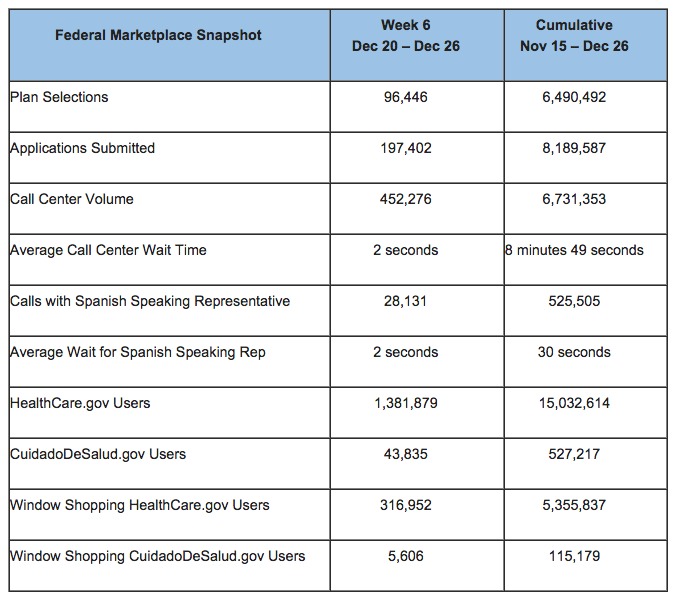Worth Noting: There's at least 1.7 million QHP applications still out there.
In all the fuss and bother over yesterday's monthly HHS report (which only ran through the 15th), I almost forgot about the HC.gov-only "weekly snapshot" which was also released at the same time. This report only covers the 37 states run via the federal exchange, but is more recent; it goes all the way up through December 26th, just 5 days ago.
I did acknowledge the 96,446 additional QHP selections since the previous week at the very end of my analysis of the monthly report, but didn't look at the rest of the weekly report at the time. There's not a whole lot of new data here, but there are a couple of noteworthy tidbits:
- "Now that automatic re-enrollment is complete, snapshots will no longer include a breakdown between new consumers and consumers renewing coverage. Our current analysis indicates that approximately 40 percent of current Federally Facilitated Marketplace consumers came back, updated their applications and actively selected a plan for 2015. We expect to release additional information about automatic and active re-enrollment in upcoming monthly reports."
Last week, HHS Sec. Burwell gave a vague "high 30's" when asked what percentage of the renewals as of the 4.48 million HC.gov renewals were actively renewed/re-enrolled versus the number who were automatically renewed in their existing account. The actual breakdown appears to be:
- 1.79 million active renewals/re-enrollments
- 2.69 million automatic renewals
- 1.91 million new enrollees
Of course, over the following week, another 96,446 new enrollees were added for the current total of 6.49 million.
The other noteworthy news here: The total number of applications submitted is now up to 8.19 million people.
I don't know whether that total includes those 2.69M autorenewals or not. Logic suggests that it shouldn't, since "applications" implies someone actually creating an account and filling out new info, which was not the case for autorenewed enrollees. However, if they aren't included, the implications are rather amazing.
8.19 million applications total minus 6.49 million plan selections = 1.7 million potential QHP enrollees who still haven't selected a plan yet...but the vast majority of them presumably will do so soon. If 90% of them do so, that's at least another 1.5 million who will be added to HC.gov, which is very good considering we're only halfway through the enrollment period. This is the most likely scenario.
However, if it's actually 8.19 million applications total minus 3.7 million plan selections (that is, if the application number does not include autorenewals), that means a whopping 4.49 million additional potential enrollees who've submitted their info but not selected a plan yet.
If that's the case and 90% of them eventually enroll, that's another 4 million via HC.gov alone, which would bring the HC.gov total to 10.5 million...and wouldn't even include any state exchange enrollees. Add them in and you'd be talking about upwards of 14 million people...and that's not including enrollees from future applications.

And remember, this is just for the federal exchange. I don't have a ton of data for the state exchanges when it comes to "applications" or "elegibility determinations", but just to give a taste, check out Massachusetts:
- They have a total of 151,764 QHP elegibility determinations (ie, "applications")
- A bit over 50% have selected plans; likely around 80,600
- That leaves around 71,000 potential QHP enrollees who've already submitted their paperwork but haven't selected a plan yet.
Other states presumably also have tens of thousands of "application submitted but no plan selected yet" accounts out there as well.
Again, not all of these applications will be converted into actual enrollments. Some may be multiple accounts under the same household; some may have been created accidentally; some will change their mind and not bother finishing the process. Even so, that's still a whole lot of people who went through the trouble of taking it this far; I presume the vast majority will go the rest of the way and actually select a plan soon.
UPDATE: In a Twitter discussion with Dan Diamond, Alex Wayne, Andrew Sprung and Pradheep Shanker, some other points were raised:
- Last year, there were a total of 13.5 million "elegibility determinations" but only 8 million "plan selections" by the end of the year (about 60%)
- However, a huge number of these were likely abandoned/redundant applications off of duplicate accounts, etc, due to the ugly technical problems HC.gov (and some state exchanges) were experiencing on. This year, there should be far fewer "duplicates" although the renewal/autorenewal factors could cancel that out (how many people thought they had to create a new account not realizing they could use their existing one for most states?)
- In addition, last year most of the "abandoned" applications were for those who didn't qualify for subsidies (who likely decided to go off-exchange instead, since the subsidies are the only compelling reason to enroll via the exchanges anyway).
- However, this year there should be far fewer "didn't qualify for subsidy" abandoned applications as well, because this year it's far easier to find out whether you qualify for one before you go through the process. Remember, one of the bigger screw-ups (a completely avoidable one at that) last year was the decision not to include a "window shopping" feature. That meant that everyone had to go through the process of creating an account and plugging in all of their personal income/household information before they could even find out what their options, prices or potential tax credits were. This was fixed in early November, I think, but I know a ton of accounts were created before then by people who just wanted to know whether they could get a tax credit or not.
In other words, the "unselected application" number is worth keeping an eye on, and will probably have a higher batting average than last year (in fact, it's already close to 80%), but it's not necessarily indicitative of anything.



